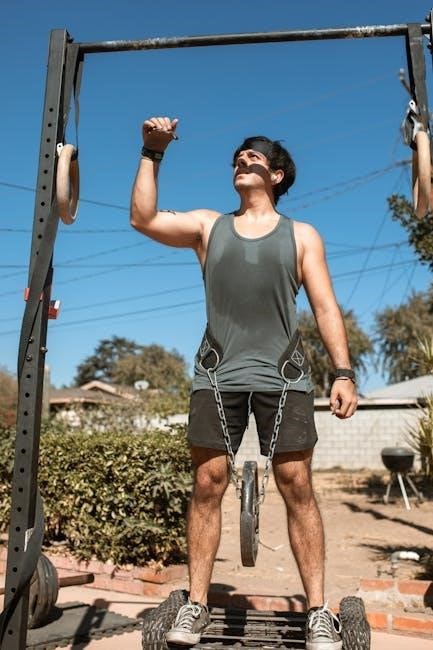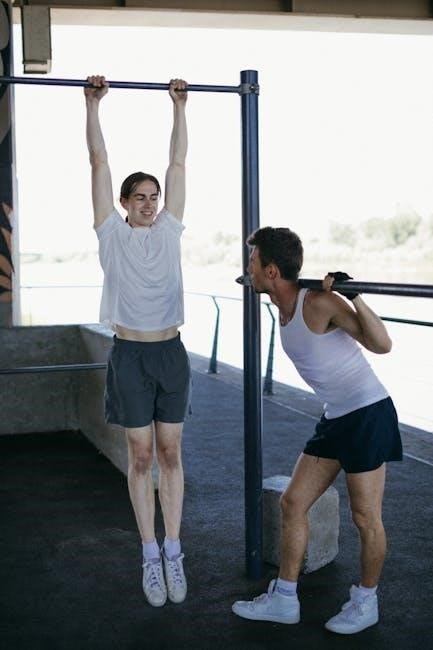Pull-up training programs offer structured approaches to building strength and endurance․ Comprehensive guides, including downloadable PDFs, provide detailed workouts, nutrition advice, and recovery strategies for all fitness levels․
Overview of the Importance of Pull-Ups in Fitness
Pull-ups are a cornerstone of strength training, targeting multiple muscle groups like the lats, shoulders, and arms․ They improve overall upper body strength, endurance, and posture․ Pull-ups also serve as a key indicator of fitness level and functional mobility․ By engaging multiple muscles simultaneously, they enhance coordination and athletic performance․ Regular pull-up practice boosts muscle mass and bone density, reducing injury risk․ Their accessibility with minimal equipment makes them a versatile and efficient exercise for any fitness routine․ Incorporating pull-ups into your regimen can significantly enhance overall physical fitness and athletic capabilities․
Structure and Goals of a Pull-Up Training Program
A pull-up training program is typically structured in phases, starting with foundational strength and progressing to advanced techniques․ The primary goal is to build the endurance, strength, and technique needed for successful pull-ups․ Programs often include variations like negative pull-ups, lat pulldowns, and deadlifts to target assisting muscles․ The structure may involve 6-week or 9-week plans, with specific days dedicated to endurance, strength, and recovery․ Goals include increasing pull-up numbers, improving overall upper body strength, and enhancing functional fitness․ The program is designed to be adaptable, allowing individuals to progress at their own pace while ensuring consistent improvement and avoiding plateaus․
Understanding Your Current Fitness Level
Assessing your current fitness level is crucial for designing an effective pull-up program․ Evaluate your strength, endurance, and technique to set realistic goals and choose appropriate exercises․
How to Assess Your Pull-Up Capability
Evaluating your pull-up ability is the first step in creating an effective training program․ Start with a max effort pull-up test to determine your current capacity․ If you can perform pull-ups, note the number of reps․ If not, assess your strength with negative pull-ups or lat pulldowns․ This baseline helps identify weaknesses and sets realistic goals․ Use the results to choose the appropriate exercises and intensity level for your fitness stage․ Progress gradually, ensuring each workout builds on your current capabilities for steady improvement․ A clear assessment ensures a tailored and effective training plan․
Setting Realistic Goals Based on Your Assessment
Setting realistic goals is crucial for a successful pull-up training program․ Based on your assessment, define achievable milestones, such as increasing pull-up reps or progressing from negatives to full pull-ups․ If you’re starting with zero pull-ups, aim to perform assisted or negative pull-ups first․ For those with some ability, focus on increasing reps or reducing assistance․ Break your long-term goals into weekly or bi-weekly targets to track progress․ Adjust your goals as you improve, ensuring they remain challenging yet attainable․ Celebrate small victories to stay motivated and maintain consistency in your training routine․

6-Week Pull-Up Training Program
This structured 6-week plan focuses on building pull-up strength progressively․ It combines foundation exercises, strength training, and recovery days, ensuring balanced development from basic to advanced levels․
Day 1: Foundation and Endurance
Day 1 focuses on building a strong foundation and improving endurance․ Start with a dynamic warm-up, then perform a pull-up assessment to gauge your current ability․ If you’re a beginner, incorporate negative pull-ups and assisted pull-ups to build strength․ For intermediates, aim for controlled sets of 3-5 reps to enhance endurance․ Finish with lat pulldowns and rows to target supporting muscles․ Proper form is crucial to avoid injury and maximize progress․ Rest for 90-120 seconds between sets and adjust the volume based on your fitness level․ Consistency and gradual overload are key to building a strong foundation․
Day 2: Strength and Progression
Day 2 emphasizes building strength and progressive overload․ Start with a dynamic warm-up, then focus on weighted pull-ups or resistance band-assisted pull-ups to increase intensity․ Perform 4-6 sets of 3-6 reps, prioritizing controlled movements and full range of motion․ Incorporate deadlifts and bent-over rows to strengthen your pull muscles․ For beginners, use negatives or isometric holds to build strength․ Gradually increase reps or weight each week to challenge your muscles․ Finish with core exercises to improve stability․ Rest for 90-120 seconds between sets and ensure proper form to prevent injury and promote consistent progress․
Day 3: Recovery and Mobility
Day 3 focuses on active recovery and mobility to enhance flexibility and reduce muscle soreness․ Begin with a light warm-up, such as dynamic stretching or yoga, to improve blood flow․ Incorporate foam rolling and self-myofascial release to target tight muscles, particularly in the shoulders, back, and arms․ Perform gentle mobility exercises, like scapular push-ups and cat-cow stretches, to maintain range of motion․ Optional low-intensity cardio, such as cycling or swimming, can aid recovery without overexertion․ Prioritize rest, hydration, and proper nutrition to support muscle repair and growth․ Avoid heavy lifting to allow your body to recover effectively․
Day 4: Power and Variation
Day 4 focuses on building power and incorporating pull-up variations to target different muscle groups․ Start with wide-grip pull-ups to engage the lats, followed by neutral-grip pull-ups for the upper back and arms․ Introduce weighted pull-ups to increase intensity․ Perform explosive plyo pull-ups to enhance power output․ Include variations like towel pull-ups or L-sit pull-ups to challenge grip strength and core stability․ Assistance exercises like lat pulldowns and deadlifts can further strengthen assisting muscles․ Focus on progressive overload and maintain proper form to maximize gains․ This day emphasizes diversity in training to avoid plateaus and enhance overall pull-up performance․
Day 5: Intensity and Challenge
Day 5 is designed to push your limits with high-intensity workouts․ Perform AMRAP (As Many Reps As Possible) sets of pull-ups to test endurance․ Incorporate supersets, combining pull-ups with weighted dips or leg raises for added challenge․ Introduce advanced variations like one-arm assisted pull-ups or archer pull-ups to target specific muscles․ Include timed challenges, such as completing 50 pull-ups in under 10 minutes․ Finish with core-strengthening exercises like hollow-body holds or weighted planks․ This day focuses on mental toughness and physical resilience, ensuring progressive overload to drive results․ Keep rest periods minimal to maximize intensity and muscle engagement․
Day 6 and 7: Rest and Recovery
Days 6 and 7 are reserved for complete rest and active recovery․ Avoid any pull-up or intense upper-body exercises to allow your muscles to repair and grow․ Engage in light activities like stretching, yoga, or leisurely walks to promote blood flow without strain․ Use foam rolling or massage to relieve muscle tension․ Prioritize sleep and nutrition to support recovery․ Reflect on your progress and adjust your plan as needed․ These days are crucial for preventing overtraining and ensuring long-term progress in your pull-up journey․ Rest is as important as training for achieving strength and endurance goals․ Stay consistent and patient․
9-Week Advanced Pull-Up Program
This program is designed for those with a solid foundation, focusing on increasing volume, intensity, and targeting assisting muscles for advanced pull-up mastery and strength․
Increasing Volume and Intensity
The 9-week advanced program focuses on progressively increasing the number of pull-ups, sets, and reps to build strength and endurance․ It introduces weighted pull-ups, plyometric variations, and high-intensity interval training to challenge even experienced athletes․ The program emphasizes proper form to prevent injury while pushing limits․ Recovery strategies, such as active rest and mobility exercises, are integrated to support muscle growth and performance․ By week 9, participants can expect significant improvements in both strength and technique, enabling them to perform advanced pull-up variations with ease and confidence․
Targeting Assisting Muscles
Strengthening assisting muscles like the lats, rhomboids, and biceps is crucial for pull-up success․ Deadlifts, lat pulldowns, and seated rows are key exercises to build these muscles․ Incorporating variations such as close-grip pull-ups and weighted chin-ups further engages secondary muscles․ By targeting these areas, the program ensures overall upper body strength, improving pull-up performance and reducing injury risk․ Regular progression and variation in exercises keep the muscles challenged, promoting consistent growth and endurance․ This holistic approach ensures athletes develop the necessary strength and stability to master advanced pull-up techniques․
Incorporating Variations for Strength
Incorporating variations like wide-grip, close-grip, and weighted pull-ups enhances strength and muscle engagement․ Wide-grip pull-ups target the lats more intensely, while close-grip focuses on the biceps and upper back․ Weighted pull-ups add resistance, building raw strength․ Negative pull-ups and isometric holds improve control and endurance․ These variations prevent plateaus, ensuring continuous progress․ By rotating exercises, athletes can address weaknesses and develop a well-rounded upper body․ This approach keeps workouts engaging and ensures comprehensive muscle development, making pull-ups more achievable and strengthening overall fitness․

Key Exercises for Pull-Up Success
Pull-ups, lat pulldowns, deadlifts, and rows are essential for building strength and endurance․ These exercises target the lats, shoulders, and arms, promoting muscle growth and pull-up mastery․
Negative Pull-Ups for Beginners
Negative pull-ups are a foundational exercise for those new to pull-up training․ Starting at the top of a pull-up position, focus on a slow, controlled descent to a dead hang․ This movement strengthens the lats, shoulders, and arms, building the necessary strength for full pull-ups․ Beginners benefit from using resistance bands or assistance to perform negatives effectively․ Aim for 3-5 sets of 3-5 reps, focusing on proper form and a 3-5 second descent․ This exercise is ideal for building muscle endurance and preparing the body for more advanced pull-up variations․
Lat Pulldowns and Their Benefits
Lat pulldowns are a versatile exercise for building upper body strength, particularly targeting the latissimus dorsi muscles․ They are an excellent alternative or supplement to pull-ups, offering similar benefits while being more accessible for beginners․ By engaging the lats, rhomboids, and biceps, lat pulldowns help improve posture and enhance overall pulling strength․ Using a wide or neutral grip can vary the muscle emphasis, while progressive overload ensures continued growth․ Incorporating lat pulldowns into your routine strengthens the foundation needed for mastering pull-ups, making them a key component in many pull-up training programs;
Deadlifts for Overall Strength
Deadlifts are a cornerstone of strength training, targeting multiple muscle groups, including the hamstrings, glutes, and lower back․ They improve grip strength and overall pulling power, which are essential for pull-ups․ Deadlifts also enhance core stability, crucial for maintaining proper form during pull-up exercises․ Incorporating deadlifts into your routine builds foundational strength, helping you progress in pull-up numbers and variations․ Their compound movement nature makes them highly effective for full-body development, supporting overall fitness and pull-up performance․ Regular deadlift practice strengthens the muscles needed for efficient and powerful pull-ups, making them a key component in many training programs․

Nutrition and Recovery
A balanced diet rich in protein, carbs, and fats supports muscle growth and recovery․ Proper nutrition, hydration, and rest are crucial for optimizing pull-up training progress and overall performance․
Optimizing Your Diet for Muscle Growth
A well-balanced diet is essential for muscle growth during pull-up training․ Focus on consuming adequate protein to repair and build muscle tissue, complex carbohydrates for energy, and healthy fats for hormone regulation․ Aim to eat lean meats, fish, eggs, whole grains, and plenty of fruits and vegetables․ Proper hydration is also crucial to support recovery and performance․ Avoid processed foods and maintain a caloric surplus to promote muscle gain․ Timing your meals around workouts can enhance recovery, and consider post-workout nutrition to replenish energy stores․ A tailored nutrition plan ensures your body has the fuel it needs to progress effectively in your pull-up training․
Recovery Techniques to Enhance Progress
Effective recovery is crucial for muscle growth and performance in pull-up training․ Incorporate techniques like dynamic stretching, foam rolling, and self-myofascial release to reduce muscle tension and improve flexibility․ Ensure adequate rest days to allow muscles to repair and strengthen․ Prioritize sleep, as it plays a key role in recovery and muscle regeneration․ Additionally, consider post-workout routines such as light cardio or yoga to promote blood flow and relaxation․ These recovery methods, combined with proper nutrition, will help your body adapt to the demands of training and accelerate progress toward your pull-up goals․

Downloadable Resources
Access free PDF guides, customizable workout plans, and detailed training schedules․ These resources provide structured routines, nutrition tips, and progress tracking to support your pull-up journey․
Free PDF Guides for Pull-Up Training
Free PDF guides offer comprehensive pull-up training plans, detailing exercises, schedules, and nutrition tips․ They cater to all fitness levels, from beginners to advanced athletes․ These guides often include 6-week or 9-week structured programs with progressive overload techniques․ Many PDFs provide customizable workouts, focusing on strength, endurance, and proper form․ Some guides, like the Womens Health Ultimate Pull-Up Plan, incorporate full-body dumbbell routines․ They also emphasize recovery strategies and mobility exercises to enhance progress․ Downloadable resources like these are invaluable for anyone aiming to master pull-ups, offering clear, actionable steps to achieve their fitness goals effectively․
Customizable Workout Plans
Customizable workout plans allow users to tailor pull-up training to their fitness level and goals․ Many PDF guides offer adjustable schedules, exercises, and intensity levels, ensuring personalized progress․ These plans often include options to modify sets, reps, and rest periods based on individual capabilities․ Advanced programs may incorporate variations like weighted pull-ups or resistance bands for added challenge․ Customization enhances engagement and effectiveness, making it easier to stay motivated and track improvements․ With adaptable structures, these plans cater to diverse needs, helping users achieve their pull-up goals efficiently and sustainably․

Final Tips for Success
Stay consistent, set achievable milestones, and celebrate progress․ Maintain proper form, listen to your body, and stay motivated․ Adjust plans as needed for sustained success․
Maintaining Consistency and Motivation
Consistency is key to achieving pull-up success․ Set realistic milestones and track progress to stay motivated․ Create a routine that fits your lifestyle, ensuring regular practice; Celebrate small victories to maintain moral․ Use a downloadable PDF guide for structured planning and accountability; Stay positive and remind yourself of your goals․ Incorporate variety in workouts to avoid boredom․ Share your journey with a partner or online community for support․ Reward yourself for adherence and progress, reinforcing commitment․ Remember, consistency breeds results, so stay dedicated and patient throughout your pull-up training program․
Monitoring Progress and Adjusting Plans
Regularly track your pull-up progress to ensure you’re meeting goals․ Use a workout log or spreadsheet to record reps, sets, and intensity․ Celebrate milestones to stay motivated․ If progress stalls, reassess your program and increase volume or intensity․ Adjustments might include adding variations, weighting pull-ups, or targeting weak points․ Periodically retest your max pull-ups to measure improvement․ Stay flexible and adapt your plan as needed to avoid plateaus․ Consistent monitoring ensures your training remains effective and aligned with your goals, helping you stay focused and driven throughout your pull-up journey․


